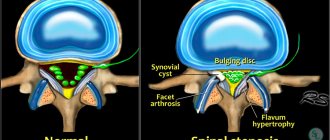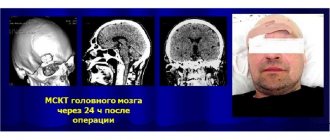Spinal cord tumors - types of tumors, features of diagnosis and treatment
Compared to brain tumors, spinal cord neoplasms are much less common in medical practice - 10-12 times.
Among all tumors of the central nervous system, spinal cord neoplasms occur in adults in 12% of cases, in children - in 5-7%.
15% of the total number of spinal cord tumors are tumors that arose primarily in the substance and membranes of the spinal cord, and 85% of spinal tumors are secondary, and are the result of pathologies affecting the bone and adjacent structures of the spinal column, as well as metastasized from tumors of other organs, most often - lungs.
Spinal tumors
Causality of spinal tumors
One of the factors in the appearance of a formation in the spine is considered to be the spinal cord, which is formed in the area of the soft tissues of the spinal cord, they are also called intradural, as well as between the soft membranes of the brain and the bones of the spine. The last cord in medicine is called extradural. However, one should also take into account the possibility of the appearance of a strand in other places.
Most of the recognized tumors are located among the meninges of the spinal cord and bones, i.e. extradural. Such formations can be either primary or secondary. It should be noted that primary formations begin in the spine itself, the latter are already a consequence of the expansion of the location of metastases formed in the organs. Typically, they occur in the lungs, mammary glands, kidneys or thyroid gland.
Any type of tumor can develop in the human spine. An exception in such cases is not lymphoma, leukemic tumor, myeloma and others. More common is the localization of the tumor near the nerves and their endings in the spinal cord. In most cases, ependymomas and gliomas are diagnosed.
At the current level of development of medicine, professors do not know the reasons for the appearance of primary tumors. Although scientists primarily highlight congenital predisposition associated with mutations as a result of the transfer of genetic information during intrauterine development of a person, as the main influencing factor in the appearance of a tumor. Another reason that may influence the risk of the appearance and development of a primary tumor is the weakening of the immune system under the influence of destructive external factors. Despite the low probability of spinal cord and spine tumors, their rapid identification and investigation is very important. This comes from the existence of many different diseases associated with back pain.
In cases where it is not possible to diagnose the disease in a short time, the formation begins to progress. Over time, the area of infection increases, namely the spinal cord tissue, its roots and vessels supplying the spine with blood and bone tissue are included in the affected area. The effect of the tumor on the body almost immediately causes signs of compression, i.e. spinal injuries. There is also the possibility of ischemia leading to temporary dysfunction of an organ or tissue.
Risk factors
Many people know for sure or at least have some idea about certain risk factors for cancer. Cancer is often diagnosed in people who smoke, as a result of poor diet, chemical attack or radiation. Although there are also cases when the patient has relatives with cancer, for example, breast or ovarian cancer. Moreover, the latter are the most significant factor in the threat of cancer. The spine has a high blood supply, as a result of which the disease can progress more rapidly than in other organs of the human body. In addition, there are cases in which cancer cells have metastasized to the bone marrow from other organs. Feeling pain in the lower back can help identify a tumor, although pain is not always a sign of a malignant tumor emanating from another part of the body, taking this into account, when contacting doctors, the patient undergoes a full examination for the possible detection of a primary cancerous tumor.
Types of tumors
Benign tumors
Benign is a tumor that has a low likelihood of metastasizing to other organs and tissues. However, this does not mean that such metastasis can be neglected. Despite their apparent harmlessness, benign tumors can cause serious problems resulting from compression of tissues and blood vessels. Thanks to medical discoveries, most tumors can be successfully treated. This applies only to those cases when the patient promptly contacted a medical institution with a specific complaint. In cases of neglect of treatment and examinations, oncology may begin to progress, resulting in complications during treatment.
To date, a number of variations of benign formations in the spine and surrounding tissues are known. It is useful to give some examples of them.
Osteoid osteoma is a benign formation that has the rare property of being found on the back of the vertebrae during puberty. First of all, it begins its development in the back of the vertebra, and not in it itself. This type of cancer is quite rare, occurring in approximately 10 percent of all possible tumors of the bone tissue of the spine. It is most often diagnosed by back pain at night. With timely contact with specialists for treatment, it is essential to get by with various NSAIDs. Often, osteoid osteoma is difficult to visualize using x-rays and the greatest effect can be obtained from the use of tomography. There are several treatment options for this cancer. First, it is effective to treat through long-term use of NSAIDs. This treatment is the most popular because the drugs can relieve or completely remove pain. Secondly, osteoid osteoma can be eliminated through surgical treatment. The most common method is radiofrequency ablation, in which local exposure to radio waves occurs on the lesion. The tumor tissue is destroyed under the influence of high temperature, so this treatment is much faster. In this case, the pain goes away in a shorter period of time, and the risk of recurrence of the disease is extremely low.
Osteoblastoma is a kind of osteoid osteoma and measures about two centimeters. This tumor is typically concentrated in the back of the vertebra. However, its manifestations are more pronounced: the patient experiences unbearable pain. When the first signs of osteoblastoma occur, urgent diagnosis and treatment are necessary. Since it has severe symptoms, the treatment and its consequences are also different. It should be borne in mind that osteoblastoma has the highest probability of appearing some time after treatment in the same place.
An aneurysmal bone cyst is also a benign tumor and occurs in the cervical vertebrae. This tumor is dangerous because it can affect both individual parts of the vertebra and its entire body. As a rule, it occurs among high school graduates. Oncology can be determined by pain and a number of neurological disorders. Aneurysmal bone cyst is a very rare bone formation characterized by a varied radiographic picture. There are several treatment options. However, it is better to use several methods together at once. Computed tomography helps determine the symptoms that are significant for all variations of ACC - diverse horizontal levels of fluid of different sizes in the pathological formation. The final diagnosis of ACC is made based on a combination of clinical and radiological data and mandatory morphological study. It is necessary to determine the most rational method of treatment. Today, the most famous is surgical, as it provides the most lasting effect.
Giant cell tumors have been little studied, but it is known for sure that the main area of their localization is the vertebral body. In most cases, the formation affects the anterior part of the spinal column. Giant cell tumors are considered benign, but at the same time they can be very dangerous and spread to other tissues through the blood. Manifestations of oncology can also be completely different, ranging from mild pain to compression of the spinal cord. As a rule, this disease affects 20-40 year old patients, although there are exceptions. You can get rid of the tumor by surgical treatment, by resection or complete removal of tissue with pathologies, or by surgical treatment. The decision regarding exactly how the patient will be treated remains his own. In some cases, a minimally invasive non-surgical procedure is applicable, as well as irradiation of the affected tissue. Such procedures have a positive effect on the outcome of treatment. For giant cell tumors, a careful approach before surgery is important, and it is necessary to study the oncology before starting treatment. Otherwise, there is a risk of the tumor degenerating into a malignant one later.
Eosinophilic granuloma is a benign formation that affects the bone tissue of the spine. It can be recognized on an x-ray by a special pattern called “vertebra plana”. This type of cancer can affect people of absolutely any age, and therefore, for each case, treatment is determined individually.
Enchondromas are benign formations that consist of cartilage tissue. During development, they can enlarge and affect the structure of the spinal cord. The optimal and most effective treatment is by surgeons to minimize the likelihood of tumor transformation into a poorly differentiated malignant cartilage formation called chondrosarcoma. Intensive tumor development requires an immediate biopsy, which prevents cells of normal or pathologically altered body tissue from acquiring the properties of a malignant tumor.
Malignant formations
Malignant tumors have properties that most often make them extremely dangerous for the life of the body. As a rule, tumors are found in an advanced form and their treatment is much more difficult than benign ones.
Malignant tumors include metastases, myeloma and osteosarcoma.
All malignant tumors undergo metastasis to bone tissue, but this is quite rare. Most often, expansion of localization occurs in the mammary glands, kidneys, thyroid gland and lungs. Depending on the case of tumor development, it can go either through veins or through arteries. The spine has a remarkable blood supply, which facilitates the spread of oncology to other organs, in particular the transfer of affected cells to the bone marrow and vertebrae. The development or metastasis of a tumor in the spine and spinal cord is possible from any part of the human body as a result of its long-term progressive development. When metastases are large enough, compression can be applied to them. After this, disturbances in the motor skills of the arms and legs appear, and this also has a negative effect on the intestines and bladder. In most cases, metastases cannot be cured, and the course of treatment is aimed at reducing the sensitivity of pain and decompressing nerve structures using surgical treatment methods. As a result of the work of specialists, it is possible to save a person’s life for as long as possible.
Multiple myeloma is the most common type of primary malignancy. This disease is typical for people over 40 years of age. In the process of cancer, bone tissue and the spine itself are affected. A cure for cancer is impossible and all doctors' actions are aimed at minimizing the manifestations of symptoms. The most current treatment method is chemotherapy, which reduces pain and the tumor progresses much more slowly.
Osteogenic sarcoma is the second most common primary malignant tumor. The entire mass of patients with this cancer can be divided into several groups: children, youth and older people. The level of development of medical technologies with competent treatment can prolong a person’s life with osteogenic sarcoma up to 5 years. This is incredible luck, since a few decades earlier similar cancerous tumors ended in death.
Leukemia has several forms of manifestation, which can be accompanied by pain in various parts of the spine. With leukemia, the temperature rises, the state of weakness is more disturbing than back pain, anemia.
Common signs of formation are pain in the spine, weight loss, and fatigue. Various signs appear to a greater or lesser extent when the body resists treatment. It must be remembered that the symptom depends on the location in the body, the type of education and the patient’s overall health.
Characteristics of pain
Pain can occur in any part of the back, although most often its source is in the middle of the back or in the lower back. As a rule, the pain decreases while lying down and increases during coughing, sneezing and various strains. The pain may spread to the hips, legs, or arms, or be persistent in the extremities.
Fighting the tumor
Before starting treatment, it is important to correctly diagnose the disease, determine the type of tumor, its development and make a tentative prognosis.
Often, one doctor cannot cope with determining the course of treatment. In these cases, a council of specialists gathers. The patient's condition is examined and first assumptions are made, then a comprehensive examination is required to avoid misdiagnosis. Once everything is determined, oncologists are ready to begin the course of treatment. In each case it is individual. It is remarkable that the developed treatment methods, when prescribed correctly, can not only save life, but also maintain it at a high quality, without limiting the person. Author: K.M.N., Academician of the Russian Academy of Medical Sciences M.A. Bobyr
Types of spinal cord tumors - classification of spinal neoplasms
1) Extradural tumors of the spinal cord (55%) are the most malignant in their course and consequences. They are distinguished by very rapid growth, which entails compression and destruction of the substance of the spinal cord.
The focus of these tumors in the vast majority of cases is located outside the spinal cord - in the bone tissue of the vertebrae and the dura mater of the spinal cord. Very rarely they are primary.
Types of extradural SM tumors:
- Metastases of malignant neoplasms in the lungs, breast, prostate.
- Granulocytic sarcoma of myeloblasts.
- A benign tumor is an angiolipoma of the spine.
2) Intradural – extramedullary tumors of the spinal cord (40%) are localized subdurally. In the vast majority of cases, these are neurofibromyomas and meningiomas.
3) Intramedullary tumors of the spinal cord (5%) – arising in the substance of the spinal cord itself, most often – astrocytomas or ependymomas from glial tissue.
How to treat
The nature of the treatment largely depends on the stage to which the cancer has progressed, access to the tumor, its size, etc. It is prescribed by the doctor for each patient individually.
Operation
It is the main method of treating cancerous tumors of the spine, including the lumbar region. However, in practice, not in all cases it is possible to remove the tumor surgically. Sometimes the tumor is localized in a hard-to-reach place or affects vital structures of the body. Surgery for cancer of the lumbar spine can be aimed at achieving the following goals: • complete removal of the tumor; • partial removal of the tumor in accessible places; • reduction of pain (in this case, treatment is palliative).
Chemotherapy
The principle of operation of this technique is to treat the tumor with special chemotherapy drugs, causing its destruction. This type of treatment is mostly used as an additional treatment. Despite many side effects, chemotherapy has the following benefits:
- slows down the growth of atypical cells;
- helps reduce tumors;
- prevents the spread of metastases.
Irradiation
This method of treatment is also additional and is aimed at consolidating the effect after surgery. At the same time, it can also be used in cases where the tumor is inoperable. Irradiation is a destructive effect on tumor cells using ionizing radiation. At the same time, other organs and tissues experience minimal radiation load.
Treatment of spinal cord tumors: conservative therapy or surgery?
The only treatment for spinal cord tumors is radical surgery to remove the tumor and the tissue affected by it.
But we must understand that the location of the pathology in this case is a complex structure that is difficult for surgical access and manipulation.
That is why early diagnosis of spinal cord tumors is very important, when the chances of effective surgery and complete removal of the tumor are high.
With correct diagnosis and timely surgery, there is a high chance of a complete cure for the patient and restoration of his ability to work.
Even with a malignant neoplasm, surgical treatment is performed in order to delay the progression of the pathological process, reduce the symptoms of neurological disorders and pain.
Conservative methods of treating spinal cord tumors - is it possible to do without surgery?
Conservative methods in the treatment of spinal cord tumors are used as auxiliary methods to reduce pain and neurological disorders.
- Therapy uses painkillers and anti-inflammatory drugs, vitamins and restoratives, and diuretics.
- The patient is prescribed a special motor regimen, given recommendations on nutrition and exercise, and may be recommended to wear a support corset and/or a Shants collar.
As a rule, treatment is performed in a hospital setting .
Unfortunately, conservative treatment alleviates the symptoms of the disease only for a while, and then the symptoms progress.
Therefore, therapy methods are used during diagnostic procedures and at the stage of preparing the patient for surgical treatment, as well as after surgery.
September 01, 2021
Diagnostics
Regardless of the part of the spine in which the tumor developed (cervical, thoracic, etc.), cancer diagnosis includes the following methods:
- A preliminary examination of the patient and analysis of his complaints - quite often at this stage a suspicion of lumbar cancer arises and additional examinations are prescribed.
- X-ray – despite the fact that this diagnostic method does not have a high level of information content, at the same time, on the x-ray you can see the displacement of the vertebrae, as well as the presence of spots on them of varying degrees of color intensity. All this is a signal for further examinations.
- CT scan – allows you to see the location of the tumor and its appearance, the stage of development of the disease. This is done using X-rays. The result is a layer-by-layer image of a specific area.
- MRI is the most effective method for diagnosing cancer of the lumbar spine. Makes it possible to see the spread of metastases to nearby lymph nodes, changes in other internal organs, the degree of damage to blood vessels, tissues, nerves, etc.
- Biopsy - this diagnostic method involves taking a fragment of the tumor for further examination for the presence of atypical cells.











